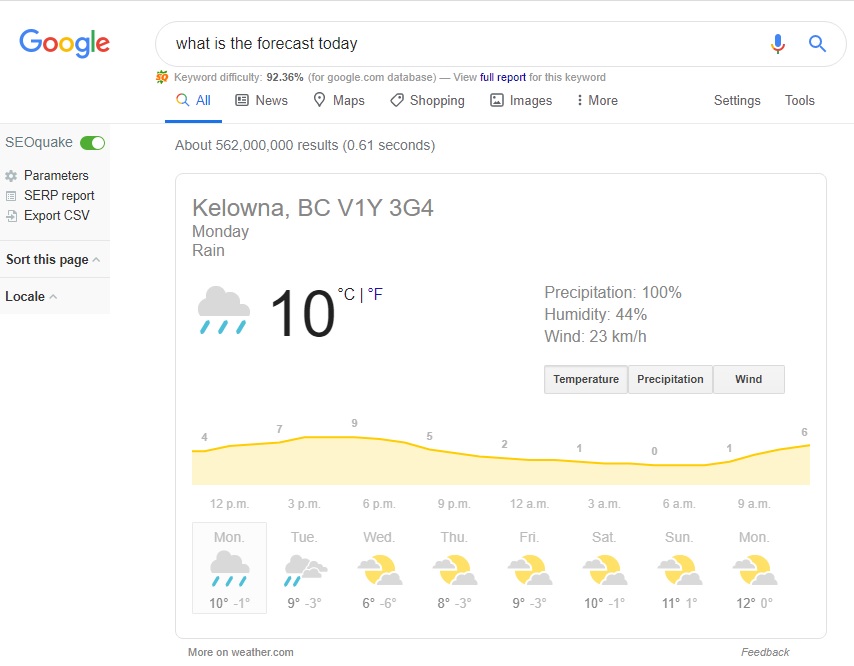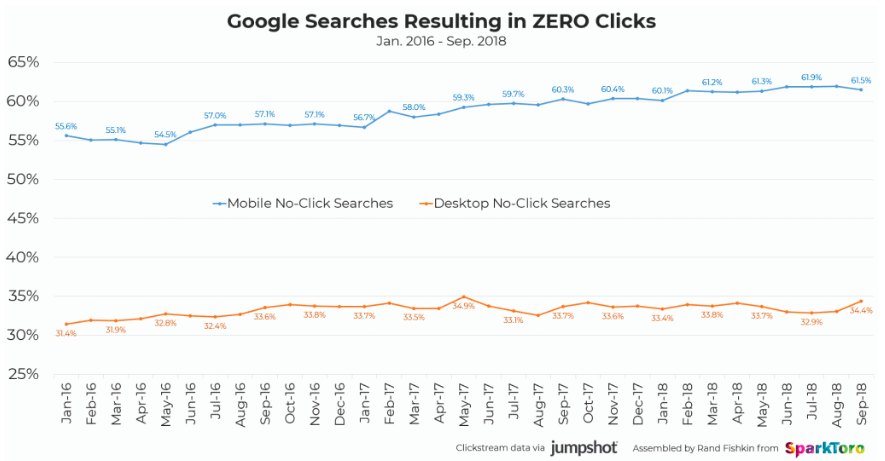June of 2019 saw an interesting turn of events where, for the first time, the majority of browser-based searches on Google resulted in zero clicks. These findings were published by Rand Fishkin, founder of SparkToro, where data was sourced from the research done by clickstream data company Jumpshot.
Digital marketers, content creators, and many others had observed the rise of no-click search results since the introduction of featured snippets to the Google search engine results page (SERP). This gave some cause for concern as everyone began to wonder how this would affect website traffic, conversions, and revenue for businesses of all kinds. Now well into 2020, the trend of zero-click searches continues and marketers are looking to navigate this evolving landscape.
While no-click searches may be cause for alarm for many, understanding, embracing, and adapting to the ever-changing search landscape remains an essential component of any digital marketing strategy. Google has evolved countless times over the past several decades and like all things, failure to adapt usually means we get left behind.
So let’s explore here what no-click search results are, their pros and cons, and how we can shift our digital marketing strategies to make the most of emerging trends.
What are zero-click searches?
A zero-click search is essentially a search query where the answer is provided directly on the SERP, therefore, eliminating the need for a user to ever click through to a website. Here’s an example of searching for the local weather forecast.

In times of old, Google would display organic listings for websites that provided the forecast, however, you’d need to click through to the website to obtain the information. Now, the query is answered right in the SERP with organic listings below it.
To take this a step further, Google even offers the answer in the address bar before it’s even finished being asked (and I didn’t even spell “forecast” correctly).

This is essentially what zero-click searches mean: a search query in which the searcher never needs to click away from the SERP to find the answer.
The controversy of zero-click searches
There is a lot of controversy surrounding zero-click searches and what that means for websites everywhere. Many believe Google is furthering its attempt to monopolize the SERP and other Google-owned properties or “steal” website traffic. Others, however, see it as a necessary evolution of the SERPs. Whether anyone likes it or not, the reality is zero-click searches are on the rise and it’s unlikely that they will reverse or plateau anytime soon.

So the best question to ask is how can we evolve with and adapt to the ever-changing search landscape? While no-click searches might mean less website traffic, lower impressions, and fewer clicks in some instances, it could also offer new unique opportunities that didn’t exist before. Let’s take a look.
The pros of no-click searches
Improving the user experience
While many see Google as trying to carve out a bigger piece of the pie for themselves, the reality is that Google is in the business of providing information to answer search intent. It only makes sense that they would continually work to improve and refine the user experience by making it as seamless and frictionless as possible.
As SEOs, we should know this and also be ensuring that we prioritize improving the user experience whenever we can. With the introduction of new technology and user behaviour that is constantly changing, failing to adapt or optimize for such things is an invitation of failure. So the introduction of zero-click searches seems to simply be Google’s way of continuing to provide a great user experience (at least that’s what it looks like on the surface).
Featured snippets are now position 1 in the SERP
Prior to January of 2020, the featured snippet was counted as “position zero” on the SERP. This is because the featured snippet appeared at the top of the page and then was followed by the classic 10 organic listings. Additionally, if you owned the featured snippet position, you could “double-dip” so to speak, by also appearing in the first 3 organic listings.
Then Google decided that in most cases, the SERP would display a featured snippet (if it existed), followed by 9 organic listings for a total of 10 (this is not taking into account other SERP features that might be present on the page).
So basically, position zero became position one. Google also removed that “double-dipping” element that existed before by removing your organic listing on the first page of the search results if you owned the featured snippet.
What this means though, is if you own the featured snippet on the SERP, you hold position one and are operating on that coveted prime real estate. While you may see fewer clicks through to your website, other advantages are that you have high visibility, improved brand awareness, improved authority, and have established trust between your website, Google, and searchers.
All of these can work together to boost your brand and revenue indirectly.
The cons of no-click searches
Fewer impressions and clicks from the SERP
Probably the most obvious cause of concern for the rise of zero-click searches is the reduced number of clicks from the SERP to the website, which means less traffic and potentially, less revenue. With information and answers provided right there, no one on the first page is likely going to see many clicks for those queries.
Basically, if you don’t own that featured snippet position (or other on-page SERP features), ranking on the first page for those queries offers little to no direct value.
Creating top level content offers reduced value
Once upon a time, informational top-level content wasn’t always as easy to come by but now, this kind of content is one of the leading types that results in zero-click searches. Currency conversions, time zones, weather forecasts and most “what is” questions are good examples of top-level informational content that will most likely result in no clicks and no real added value beyond that.
With this in mind, marketers should shift to focus on more mid-level content or constructing deeper long-form content. While you can still optimize for these featured snippets, they are highly competitive and the value of gaining them may not be worth the time, money, and effort to get there.
Ways you can optimize for zero-click searches
Whether you feel zero-click searches are good or bad, the reality is they are seemingly here to stay and the best way to move forward is to evolve, adapt, and capitalize on opportunities as they come. Here are a few ways in which you can implement SEO strategies to fight back against zero-click searches on the SERP.
Target relevant featured snippets
Identifying and going after the featured snippets and other SERP features that are most important to your business is still important. Even if it means receiving fewer clicks from the SERPs. Not only do featured snippets now count as position one on the page, but it’s the best seat in the house. Owning these snippets offers value for improved visibility, brand awareness, demonstrating authority, and building trust between Google and users. All of these will work together to indirectly recycle value back to your website and your business.
Create deeper content
The Google search results page is not designed to house in-depth content which is why it only displays “snippets” of information. This means that for search queries that require a more thorough explanation, searchers will click through to a website for that information. For featured snippets positions, if the user already feels that the snippet has begun to provide the information they are looking for, they will be more inclined to click the snippet to view that content from the source page, as opposed to scrolling down the SERP.
So long-form content that offers strong value in that sense, can possibly reap both the benefits of:
a.) owning a featured snippet position and
b.) receiving a decent CTR from the SERP via that snippet by optimizing deep content to entice searchers to see more
Monitor the metrics that matter
When it comes to no-click searches, monitoring your CTR from the SERP might not be one of the best metrics to focus on. Instead, consider how zero-click searches might indirectly impact you in other ways and what metrics might be more useful to keep an eye on.
Perhaps you’ve noticed an increase in branded search terms since obtaining ownership of a featured snippet that displays for high search volume keywords. Maybe there’s been an improvement in the average time spent on-page. These are just a couple of examples of other metrics to monitor that might help to prove a certain value from zero-click searches, namely—when there initially seemed to be none.
Final thoughts
While the value of no-click searches might still be highly debated, it’s futile to fight against the ever-changing search landscape. Instead, marketers should begin to strategize on ways they can align themselves with this momentum and look for new innovative ways to capitalize on it. Google will continue to prioritize constantly improving its user experience. As SEOs, it is our job to do the same.
Even though overall clicks and impressions from the SERP might be lower for those zero-click searches, there is still tremendous value in operating within that prime first spot on the results page and that will continue to contribute positively to your overall SEO efforts.

